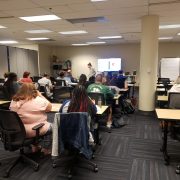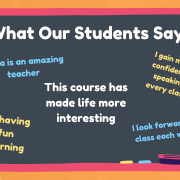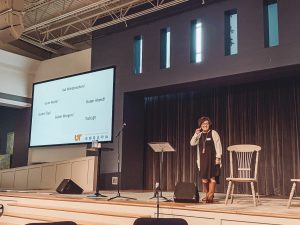Recently, when gathering competitive intel on the website of one of our competitors, I noticed that they cap their class size at 6 (six!), arguing that this way the class can remain true to the chosen approach of “personalized and conversational”. In the same vein, I have also heard from our students who happened to be in a class of more than 10 students, that their class was too big! And a prospective student pointed out that she likes her class to be between 6 and 8 students, reason being the amount of time she would get to speak in class. It appears then, students’ common preference is to be in small classes (and by that they mean less than 10), so let’s investigate if there are actual benefits of being in a class this small, and whether – specifically for a language class (for other class types it’s not!) – smaller is better all the way down to 1-on-1 classes.
The “conversational” aspect and Student Talking Time
It’s en vogue, and for a good reason, to be in a class that focuses on conversation. So what makes a class a conversational one? It’s the amount we talk, and specifically, the amount each student talks in class. Do we get to talk less when there are more students in class? Only if we assume that all the conversations are “teacher-to-student”, i.e. only one student at a time gets to talk and their talking partner is the teacher. If this is the type of the class you’re in, then it’s not a very good class. What we need to do to truly maximize the Student Talking Time is for students to converse in pairs, groups or with multiple partners within an activity. The role of the teacher in class is not to be a conversation partner for a student: his/her role is to facilitate such meaningful exchanges between students that they can go off on their own talking to each other.
The principle is similar to a party: you don’t expect to speak less at a party with a lot of people. On the contrary, the more people there are, the more likely you are to find yourself exchanging many different experiences and viewpoints with different people. You are also more likely to find people you like there, even if one or another conversation partner rubs you the wrong way, makes weird remarks, or is plain annoying. At a small party, you might end up speaking to just one or two people all night and, if the other two present are weirdos, not a good party, not a good class. Bottom line: want a truly conversational class? Find a group of at least 10 people with a teacher who is a facilitator, not a talker.
Personalized approach
In language classes as well as in schools and colleges, there is the hope that a student will receive a more personalized approach in a small class. Even in this aspect, the small class fails to deliver on expectations. Many observations and much research shows that, in reality, teachers tend to follow the same pace and curriculum regardless of the class size and composition; without much consideration for what their students’ strengths, weaknesses and preferences are. Many teachers simply don’t have specific tools to address the each student’s particular struggles, even if they have the time to do it in class. At the same time, state-of-the-art methodologies are so well researched and advanced that the vast majority of students (barring specific learning disabilities) will do very well in a class built around strong structure, a variety of activities and materials, and with a respectful and enthusiastic teacher.
Reminder: learning styles are a myth, which also takes off the edge of the “personalization” argument.
Team benefits
From our observations of many years, every class needs a critical mass of median students who constitute the healthy core setting the pace for the class. Among 4 or 6 students, it may feel that everyone is at a different proficiency level, almost like a dataset with only outliers. If we have 12 to 14 students, we are much more likely to have a group of students right on par for the course and, even if there are outliers (weaker and stronger students), the class continues to learn at a healthy pace while the teacher makes adjustments to accommodate the outliers. In this class, if someone misses a session or two, there are others to help them out; if an activity is particularly difficult, there are still 2 to 3 students who get it and can assist others. In other words, the class has a greater sum of total knowledge and skills to fall back on. The underlying principle here is that we learn a lot from our peers (more than from the teacher!), so we need peers and a number of them to that!
In this sense, a language class is like a team of synchronized swimmers, cheerleaders, or a marching band: you will find that each member relies a lot on the group to deliver their portion of the performance and they would really struggle having to perform their own part solo without the group, no matter how good they are. That’s why one-on-one language classes are not as effective as many people think. They are like running a marathon on your own. Deprived of the camaraderie (or the ”party effect”) of a bigger class, moral support of your peers, and having to interact with only one person who is way-out-of-your-league as far as language proficiency (the teacher), makes one-on-one classes a true challenge. Because language learning is a very long process, you’re in it for years and you need all the positive incentives you can get to stick to it. Being part of a group is one incentive, and indeed we observe, term after term at TFLI, that members of bigger groups continue to come to class, do homework and improve their language skills for a much longer time (measured in total hours of class taken) than students in small or individual classes.
There are, of course, exceptions: rare languages learned for specific purposes (job, moving to a new country), where the motivation is so high that the learner will improve with or without camaraderie; or students already quite proficient in the language, working to fix a specific deficiency (e.g. academic writing); or those who don’t enjoy parties and the conversation part is more a burden on them than something to enjoy or prioritize. Shy or introvert students, for example, improve their speaking or conversation skills slower than they improve in other areas. Even those, though, are more likely to find a buddy in a bigger class and they need the buddy to help them feel at home in a class.
At TFLI we would like to have classes of around 12 so that students can take advantage of all these benefits, but we are also strict at capping classes at 16 in accordance with ACTFL guidelines. We do want the teacher to get enough opportunities to listen to students, observe their progress, assess their performance, provide feedback, know their interests and personality, and act on this knowledge.
Bottom line: there is such thing as a too small language class, but a class bigger than 16 is inefficient and overcrowded.





